 |
|
|
| Return to front page | Return to News Archive |
| [Ben]: | Camping report | Discuss This [3 comments so far] View Comments | In part inspired by article on conducting impulse camping trips, Jon and I took off for the Charles C. Deam Wilderness Area near Bloomington, IN. In our infinite wisdom and with the full prior knowledge that the weather was to be stormy and cold, we forsook such extravagances as tents, plentiful food and warm clothing in favor of a tarp, emergency supplies and no bake cookies.
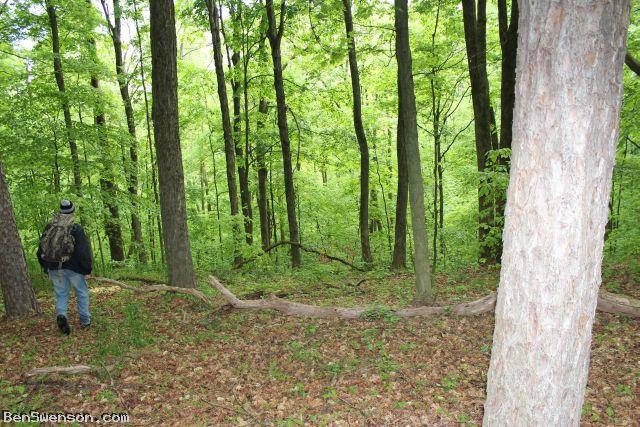
We started early on Saturday and arrived at the wilderness around 0730. We started out by climbing up the Hickory Ridge fire lookout tower and almost immediately the rain and wind kicked up – catching us without our rain gear. Well, it didn't take long to get rained on, that's for sure. By the time we got down the tower, the rain had died down so we grabbed our packs and started out on the trail. We hiked 1.5 miles down a trail then cut down a ravine, across a creek and up a steep hill where we found a great spot to camp. Our campsite was about two thirds of the way up a hill on a protrusion large enough for a few trees. The geography was such to provide adequate shelter from wind and protect us from runoff.
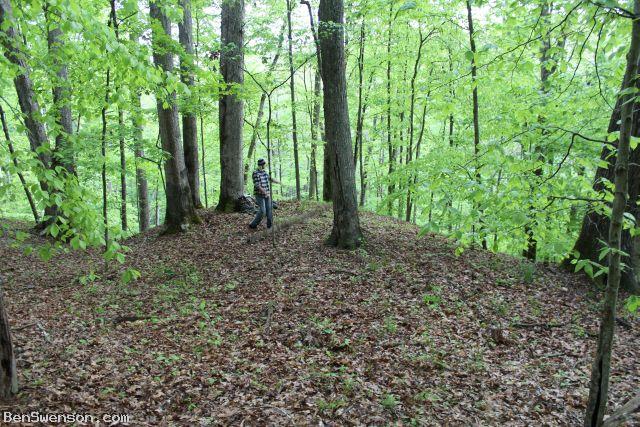
After picking our spot, Jon started on the shelter and I started on setting up the fire. He tied up some 550 cord and started pitching a debris lean-to. I painstakingly dug a small Dakota fire hole nearby. At the end we switched and I put some finishing debris on the lean-to while Jon tried making fire with wet tinder and his firesteel. Eventually we got one going to much rejoicing.
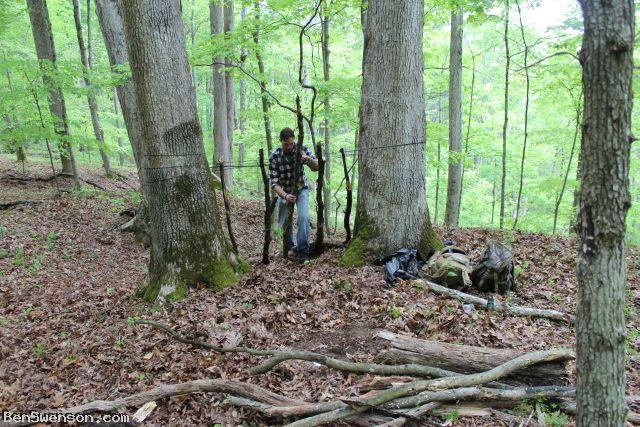
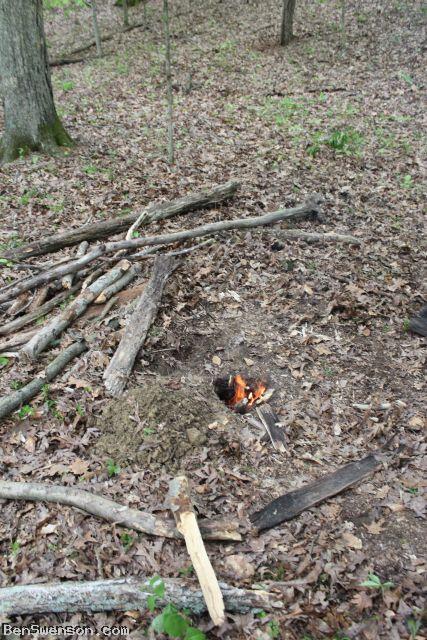
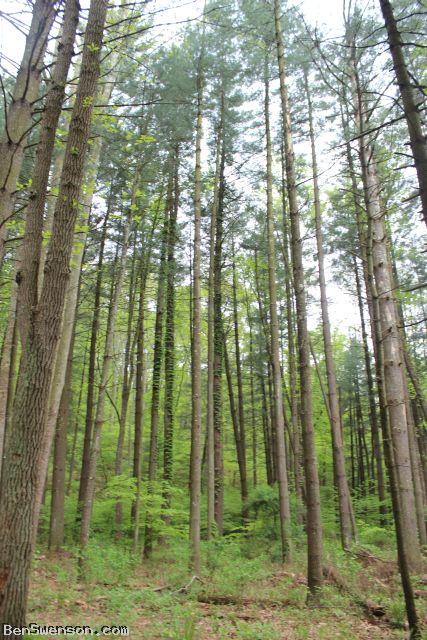
Jon wanted to hike out to the lake, so we marked our camp, killed the fire and started out. We hiked back to the creek we had crossed and followed it down to the lake. Along the way we came across loads of geodes, a few old fire rings and lots of deer sign. As we got closer to the lake we hit a large, dense expanse of scrub brush that made progress very slow going. We stopped so Jon could climb a tree and see how close we were to the lake, and while he was looking about we heard lots of splashing. After shoving our way through a bunch more scrub brush and into steadily stickier and deeper mud, we came to a point we could see water churning in several spots around the shallows. Jon shucked his shoes and set out to investigate what turned out to be fish growing getting acquainted with each other.
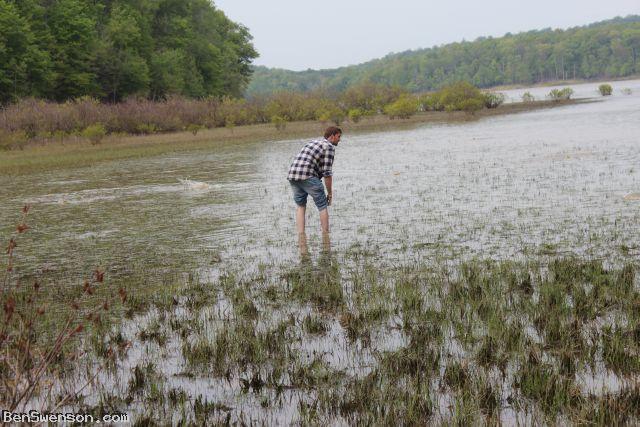
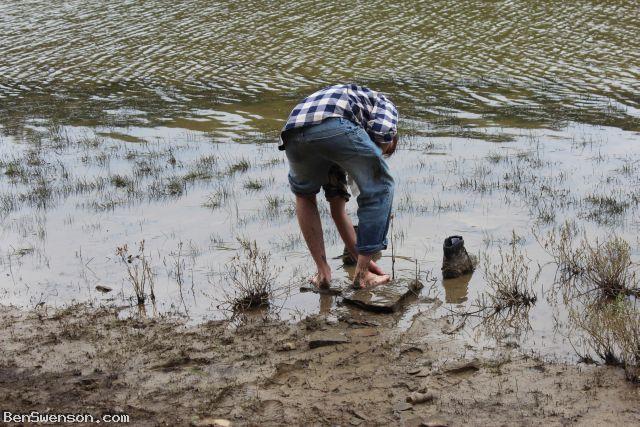
We mucked over to an area that had a few rocks near enough to the water that Jon could wash up. He decided to explore some areas east. Along the way we came across a survey marker from the Army Corps of Engineers. Lake Monroe was constructed between 1960 and 1965 and this survey marker was put into place towards the end of that period.
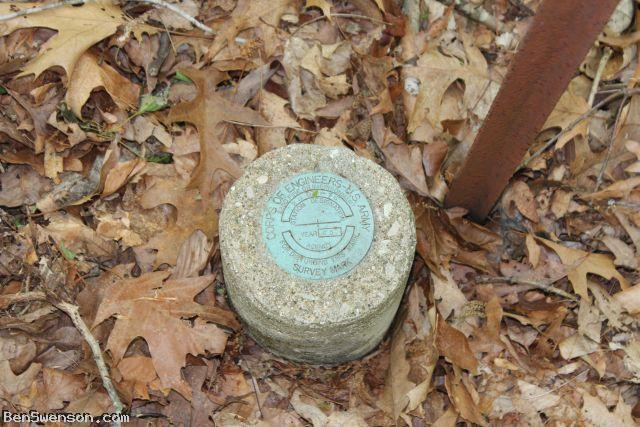
Finally, we decided to make for one of the main trails. As we bounded over hill and vale, we noticed a tumbledown brick structure with a pretty good sized chimney. Of course we had to investigate the building. Turned out someone had been using it relatively recently to camp in and had left quite a bit of trash inside.
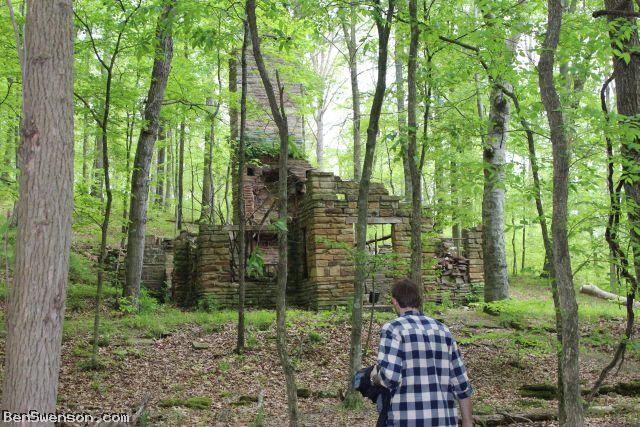
We practiced orienteering a bit in trying to return to the trail, but ended up resorting to GPS – more to reduce the amount of climbing we'd have to do than because we were having trouble finding our way back.
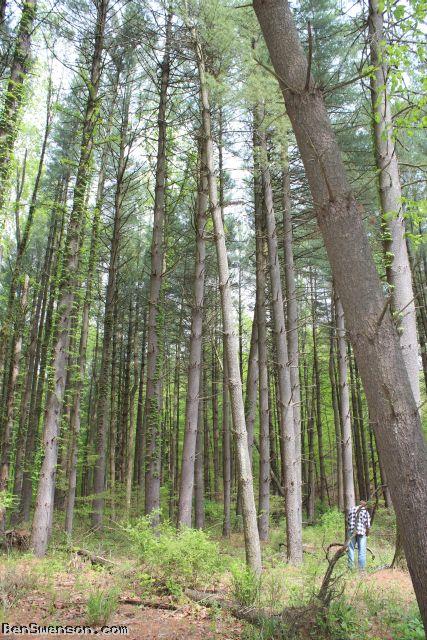
Once we hit the trail, we headed back for the car to refill our water and pick up a few things we'd left behind. When we got back to camp, we napped for a bit until thunder started to ricochet off the trees. We augmented our debris hut with a tarp overhang and a space blanket reflector for the fire, and then set about eating our emergency rations. They were surprisingly edible and I will likely buy some more to keep around. After that it was pretty much sit around the fire and talk until we went to bed.
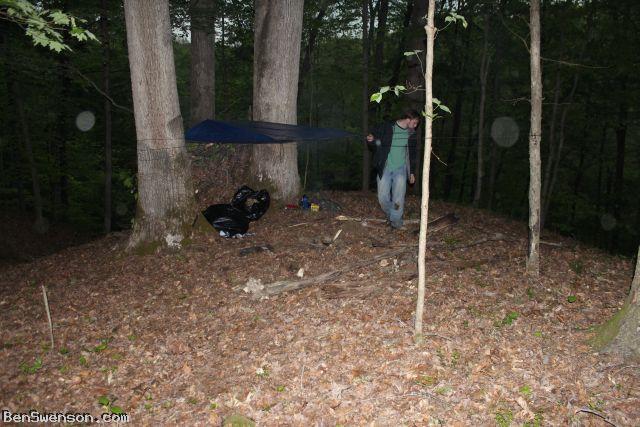
The night was pretty cold, and the rain came and went until about 0300. The shelter kept the worst of it off, and we were positioned well to not get drainage through our sleeping area, but I ended up a little cold and wet regardless. I drifted in and out of sleep a lot but never really settled in to a solid rest. At one point I woke up and noticed an eerie green glow coming from about six feet away from the shelter. It was sitting near our wood pile and when I got closer I realized it wasn't just close to the wood, it actually was a chunk of wood. I had dragged a small dead tree down the hill and where the wood was exposed, the stump of the tree was glowing. Another stick nearby was glowing as well, which was really cool. I think that's the first time I've seen foxfire, although Jon has seen it before.
Around 0300 the rain stopped and I built a fire. With the rain no longer an issue and the area kept much warmer by the fire, we both slept well after that. In the morning we had our breakfast and decided to clean up the campsite before we did anything else. We got the lean-to torn down, the debris scattered, our bags packed and the fire snuffed, then moved on to trying to find one of the many ponds that dot the ridges in the area. We got to it the hard way, and then got back to our camp the easy way. After policing the area one last time, we hoisted packs and started the hike back to the fire tower. We climbed the tower one last time before we left and I got a few pictures. Then, already starting to slow down from the soreness, we packed it in and headed for home.
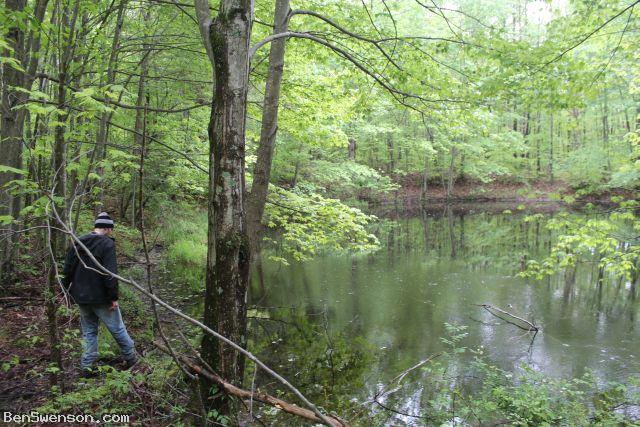
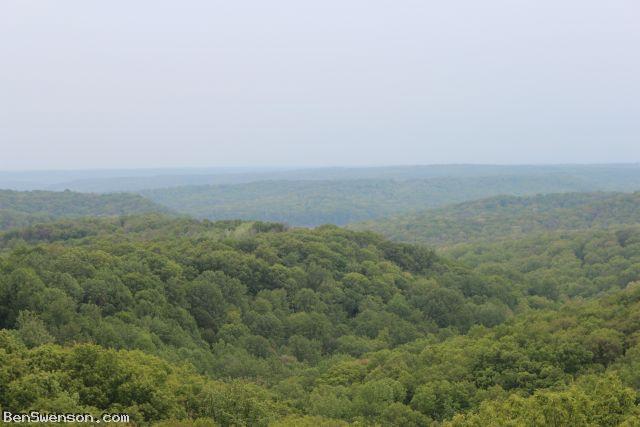
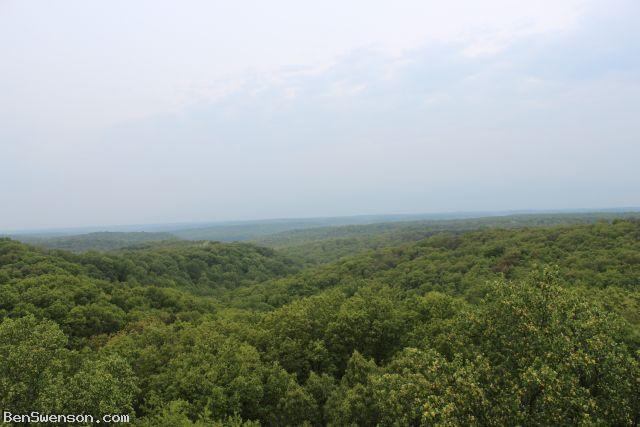
All told (just did some measurements to validate this) we hiked almost 9 horizontal miles, most of that up and down steep 250 foot ravines and hills.
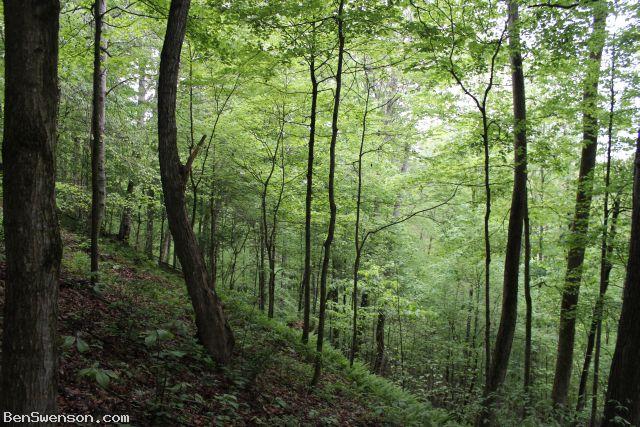
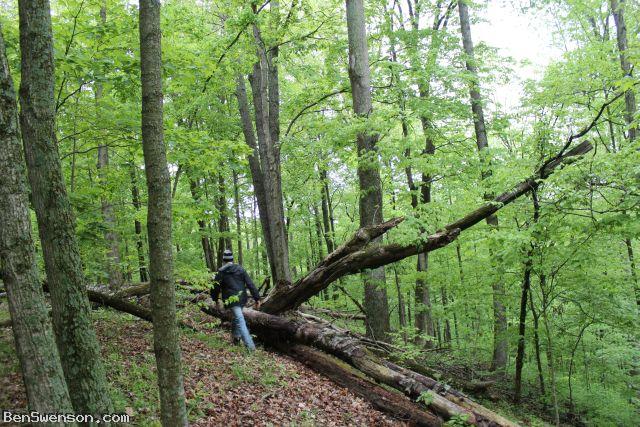
During our trip we got to try out some equipment and supplies that have seen either very little use or never been tried. In the spirit of recording what we learned while it is still fresh, here are some things I remember. Hopefully Jon will jump in when he gets a chance.
1. Emergency rations have come a long way.
The last time I tried emergency food was ten or twelve years ago when I ate some expired supplies from our old California earthquake kit circa 1994. That stuff tasted like pressed sawdust, rancid fat and paraffin wax. It probably had the calories to keep you alive, but you'd have to be ready to die before you'd want to eat the stuff. Jon and I tried two different kinds of emergency food: Mayday 2400 calorie apple cinnamon emergency rations and the Datrex 2400 calorie emergency rations.
The Mayday tasted almost but not completely unlike apple cinnamon, but was good nonetheless. These ration blocks are nice and flat and pack pretty easily but were quite hard and had to be broken into individual servings. Once you had your chunk you had to gnaw off bits to eat. Even so, it was pretty tasty, didn't make us too thirsty and filled us up. Also, the packaging needed to be cut open. I'm not sure what kind of person would be stuck somewhere with survival rations and no knife, but they would have to work hard to get the packaging torn open if they were.
The Datrex bars come in a cube that doesn't pack nearly as well as the Mayday. On the plus side, it is easily opened without a sharp object and the servings are individually packed. While it may look like little bars of soap made from sawdust, it actually had a very nice cookie-like consistency and tasted pretty good. It didn't seem to make me as full as the Mayday bars, but wouldn't be a disappointment if the alternative was nothing at all.
2. Fire tricks
We started out playing with firesteels and scrounged tinder but had limited success. Tinder tended to be wet from the on and off rain that had been going on for a few days already and – as usual – we rushed into playing with the firesteels instead of having a proper place to put the flame once we got it.
Saturday we used a Dakota fire hole for our fire which worked well. The downsides were that it was hard to dig one so close to trees and I dug the air hole too small. Still, it was very efficient with the wood and did a good job for what we needed it to do. Sunday just after the rain stopped, I was able to get a fire going very quickly by using a votive candle from my candle lantern. I built a large teepee of small twigs over the candle and lit it, and before long was adding much larger sticks. The fact that we were able to get this going right after the rain quit really sells me on the idea of keeping small candles in backpacking and emergency gear.
3. Shelter and sleeping gear
We didn't bother to bring sleeping bags or tents, but the shelter was almost sufficient. I brought two Coghlan's Emergency Blanket/Bags which would serve to keep the rain off, wind off and (hopefully) keep us warm. It did the first two pretty well, but I was not impressed by the warmth. Jon and I were wearing multiple layers, our boots, jackets and some rain gear. Even with all that and the mylar bag over everything, I was uncomfortably cold. The temperature hit a low of about 46 degrees F, and I would have expected the bags to do a better job than that. At the price, size and weight, it probably is still a good idea if only to stay dry, but don't expect to stay cozy if the temperature goes very low at all. It might help you survive, but I wouldn't depend on it for long.
I had a wool blanket with me, and it did a little better job at keeping me warm than my mylar bag. Around 0130 I managed to tear my mylar bag and ended up just using it as a ground cloth. The wool blanket never felt cold, even though it got damp. That's a huge deal, and a major strength of wool. |
| 2012-05-01
Permanent Link:
Camping report |
| |
|
|
|
|